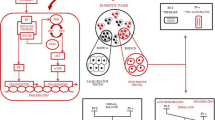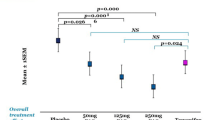Summary
At least half of all advanced breast cancers are positive for estrogen receptor (ER) and progesterone receptor (PR), but many nevertheless fail to respond to endocrine therapy. Studies of breast cancer cell lines and breast tumor specimens are beginning to reveal molecular heterogeneity of the receptors in subpopulations of these cells, leading to altered receptor function and sometimes to hormone resistance. Here we will review the data on molecular and cellular heterogeneity involving ER and PR, and possible underlying mechanisms of resistance to tamoxifen and progestins.
Similar content being viewed by others
References
Green S, Walter P, Kumar V, et al: Human oestrogen receptor cDNA: sequence, expression, and homology to v-erb-A. Nature 320:134–139, 1986.
Greene GL, Gilna P, Waterfield M, Baker A, Hort Y, Shine J: Sequence and expression of human estrogen receptor complementary DNA. Science 231:1150–1154, 1986.
Ponglikitmongkol M, Green S, Chambon P: Genomic organization of the human oestrogen receptor gene. EMBO J 7:3385–3388, 1988.
Kumar V, Green S, Staub A and Chambon P: Localisation of the oestradiol-binding and putative DNA-binding domains of the human oestrogen receptor. EMBO J 5:2231–2236, 1986.
Kumar V, Chambon P: The estrogen receptor binds tightly to its responsive element as a ligand-induced homodimer. Cell 55:145–156, 1988.
Guiochon-Mantel A, Loosfelt H, Ragot T, et al: Receptors bound to antiprogestins form abortive complexes with hormone responsive elements. Nature 336:695–698, 1988.
Baulieu E-E: Steroid hormone antagonists at the receptor level: A role for the heat-shock protein MW 90,000 (hsp 90). J Cell Biochem 35:161–174, 1987.
Fawell SE, Lees JA, White R, Parker MG: Characterization and colocalization of steroid binding and dimerization activities in the mouse estrogen receptor. Cell 60:953–962, 1990.
Adler S, Waterman ML, He X, Rosenfeld MG: Steroid-receptor mediated inhibition of rat prolactin gene expression does not require the receptor DNA-binding domain. Cell 52:685–695, 1988.
Washburn T, Hocutt A, Brautigan DL, Korach KA: Uterine estrogen receptor in vivo: Phosphorylation of nuclear-specific forms on serine residues. Molec Endocrinol 5:235–242, 1991.
Murphy LC: Estrogen receptor variants in human breast cancer. Molec Cell Endocrinol 74:C83-C86, 1990.
Hill SM, Fuqua SAW, Chamness GC, Greene GL, McGuire WL: Estrogen receptor expression in human breast cancer associated with an estrogen receptor gene restriction fragment length polymorphism. Cancer Res 49:145–148, 1989.
Castagnoli A, Maestri I, Bernardi F, Del Senno L: PvuII RFLP inside the human estrogen receptor gene. Nucl Acids Res 15:866, 1987.
Parl FF, Cavener DR, Dupont WD: Genomic DNA analysis of the estrogen receptor gene in breast cancer. Breast Cancer Res Treat 14:57–64, 1989.
Keaveney M, Klug J, Dawson MT, et al: Evidence for a previously unidentified upstream exon in the human oestrogen receptor gene. J Molec Endocrinol 6:111–115, 1991.
Shupnik MA, Gordon MS, Chin WW: Tissue-specific regulation of rat estrogen receptor mRNAs. Molec Endocrinol 3:660–665, 1989.
Garcia T, Lehrer S, Bloomer W, Schachter B: A variant estrogen receptor messenger ribonucleic acid is associated with reduced levels of estrogen binding in human mammary tumors. Molec Endocrinol 2:785–791, 1988.
Garcia T, Sanchez M, Cox JL, et al: Identification of a variant form of the human estrogen receptor with an amino acid replacement. Nucl Acids Res 17:8364, 1989.
Lehrer S, Sanchez M, Song HK, et al: Oestrogen receptor B-region polymorphism and spontaneous abortion in women with breast cancer. Lancet 335:622–624, 1990.
Dotzlaw H, Alkhalaf M, Murphy LC: Characterization of estrogen receptor variant mRNAs from human breast cancers. Molec Endocrinol 6:773–785, 1992.
Fuqua SAW, Fitzgerald SD, Chamness GC, et al: Variant human breast tumor estrogen receptor with constitutive transcriptional activity. Cancer Res 51:105–109. 1991.
Hirose T, Koga M, Matsumoto K, Sato B: A single nucleotide substitution in the D domain of estrogen receptor cDNA causes amino acid alteration from Glu-279 to Lys-279 in a murine transformed Leydig cell line (B-1 F). J Steroid Biochem Molec Biol 39:1–4, 1991.
Foster BD, Cavener DR, Parl FF: Binding analysis of the estrogen receptor to its specific DNA target site in human breast cancer. Cancer Res 51:3405–3410, 1991.
Scott GK, Kushner P, Vigne J-L, Benz CC: Truncated forms of DNA-binding estrogen receptors in breast cancer. J Clin Invest 88:700–706, 1991.
Horwitz KB, McGuire WL, Pearson OH, Segaloff A: Predicting response to endocrine therapy in human breast cancer: A hypothesis. Science 189:726–727, 1975.
Horwitz KB, McGuire WL: Estrogen control of progesterone receptor in human breast cancer: Correlation with nuclear processing of estrogen receptor. J Biol Chem 253:2223–2228, 1978.
Keydar I, Chen L, Karbey S, et al: Establishment and characterization of a cell line of human breast carcinoma origin. Eur J Cancer 15:659–670, 1979.
Horwitz KB: Is a functional estrogen receptor always required for progesterone receptor induction in breast cancer? J Steroid Biochem 15:209–217, 1981.
Horwitz KB, Mockus MB, Lessey BA: Variant T47D human breast cancer cells with high progesterone receptor levels despite estrogen and antiestrogen resistance. Cell 28:633–642, 1982.
Graham ML II, Krett NL, Miller LA, Leslie KK, Gordon DF, Wood WM, Wei LL, Horwitz KB: T47Dco cells, genetically unstable and containing estrogen receptor mutations, are a model for the progression of breast cancers to hormone resistance. Cancer Res 50:6208–6217, 1990.
Graham ML II, Dalquist KE, Horwitz KB: Simultaneous measurement of progesterone receptors and DNA indices by flow cytometry: Analyses of breast cancer cell mixtures and genetic instability of the T47D line. Cancer Res 49:3943–3949, 1989.
Forman BM, Yang C, Au M, Casanova J, Ghysdael J, Samuels HH: A domain containing leucine zipper-like motifs mediates novel in vivo interactions between the thyroid hormone and retinoic acid receptors. Molec Endocrinol 3:1610–1626, 1989.
Graham ML II, Bunn PA Jr, Jewett PB, Gonzalez-Aller C, Horwitz KB: Simultaneous measurement of progesterone receptors and DNA indices by flow cytometry: Characterization of an assay in breast cancer cell lines. Cancer Res 49:3934–3942, 1989.
Graham ML II, Smith JA, Jewett PB, Horwitz KB: Heterogeneity of progesterone receptor content and remodeling by tamoxifen characterize subpopulations of cultured human breast cancer cells: Analysis by quantitative dual parameter flow cytometry. Cancer Res 52:593–602, 1992.
Lerner LJ, Jordan VC: Development of antiestrogens and their use in breast cancer. Cancer Res 50:4177–4189, 1990.
Osborne CK, Coronado EB, Robinson JR: Human breast cancer in the athymic nude mouse. Cytostatic effects of long-term antiestrogen therapy. Eur J Cancer Clin Oncol 23:1189–1196, 1987.
Lippman ME: An assessment of current achievements in the systemic management of breast cancer. Breast Cancer Res Treat 4:69–77, 1984.
McGuire WL, Lippman ME, Osborne CK, Thompson EB: Resistance to endocrine therapy. Breast Cancer Res Treat 9:165–173, 1987.
Gottardis MM, Jiang S-Y, Jeng M-H, Jordan VC: Inhibition of tamoxifen stimulated growth of an MCF-7 tumor variant in athymic mice by novel steroidal antiestrogens. Cancer Res 49: 4090–4093, 1989.
Osborne CK, Coronado EB, Allred DC, Wiebe V, DeGregorio M: Acquired tamoxifen resistance correlates with reduced breast tumor levels of tamoxifen and isomerization of trans-4-hydroxytamoxifen. J Natl Cancer Inst 83:1477–1482, 1991.
Katzenellenbogen BS, Kendra KL, Normal MJ, Berthois Y: Proliferation, hormonal responsiveness, and estrogen receptor content of MCF-7 human breast cancer cells grown in the short-term and long-term absence of estrogens. Cancer Res 47:4355–4360, 1987.
Daly RJ, King RJB, Darbre PD: Interaction of growth factors during progression towards steroid independence in T47D human breast cancer cells. J Cell Biochem 43: 199–211, 1990.
Gottardis MM, Jordan VC: Development of tamoxifenstimulated growth of MCF-7 tumors in athymic mouse after long-term tamoxifen administration. Cancer Res 48:5183–5188, 1988.
Turner RT, Wakely GK, Hannum KS, Bell NH: Tamoxifen prevents the skeletal effects of ovarian deficiency in rats. J Bone Min Res 2:449–456, 1987.
Henderson IC, Harris JR, Kinne DW, Hellman S: Cancer of the breast.In DeVita VT Jr, Hellman S, Rosenberg SA (eds) Cancer: Principles and Practice of Oncology. J.B. Lippincott Co., Philadelphia, 1989, p 1252.
Legault-Poisson S, Jolivet J, Poisson R, Beretta-Piccoli M, Band PR: Tamoxifen-induced tumor stimulation and withdrawal response. Cancer Treat Rep 63:1839–1841, 1979.
Horwitz KB, Aiginger P, Kuttenn F, McGuire WL: Nuclear estrogen receptor release from antiestrogen suppression: Amplified induction of progesterone receptor in MCF-7 human breast cancer cells. Endocrinology 108:1703–1709, 1981.
Murphy LC, Dotzlaw H, Johnson Wong MS, Miller T, Murphy LJ: Mechanisms involved in the evolution of progestin resistance in human breast cancer cells. Cancer Res 51:2051–2057, 1991.
Jeltsch JM, Krozowski Z, Quirin-Stricker C, Gronemeyer H, Simpson RJ, Garnier JM, Krust A, Jacob F, Chambon P: Cloning of the chicken progesterone receptor. Proc Natl Acad Sci USA 83:5424–5428, 1986.
Conneely OM, Sullivan WP, Toft DO, Birnbaumer M, Cook RG, Maxwell BL, Zarucki-Schulz T, Green GL, Schrader WT, O'Malley BW: Molecular cloning of the chicken progesterone receptor. Science 233:767–770, 1986.
Misrahi M, Atger M, d'Auriol L, Loosfelt H, Meriel C, Fridlansky F, Guiochon-Mantel A, Galibert F, Milgrom E: Complete amino acid sequence of the human progesterone receptor deduced from cloned cDNA. Biochem Biophys Res Commun 143:740–748, 1987.
Horwitz KB: The molecular biology of RU486. Is there a role for antiprogestins in the treatment of breast cancer? Endocrine Reviews 13:146–163, 1992.
Tora L, Gronemeyer H, Turcotte B, Gaub M-P, Chambon P: The N-terminal region of the chicken progesterone receptor specifies target gene activation. Nature 333:185–188, 1988.
Kiang DT: Chemoprevention for breast cancer: Are we ready? J Natl Cancer Inst 83:462–463, 1991
Horwitz KB, Zava DT, Thiligar AK, Jensen EM, McGuire WL: Steroid receptor analyses of nine human breast cancer cell lines. Cancer Res 38:2434–2437, 1978.
Sartorius CA, Tung L, Takimoto GS, Horwitz KB: Antagonist-occupied human progesterone receptors bound to DNA are functionally switched to transcriptional agonists by cAMP. J Biol Chem 268:9262–9266, 1993.
Author information
Authors and Affiliations
Rights and permissions
About this article
Cite this article
Horwitz, K.B. Mechanisms of hormone resistance in breast cancer. Breast Cancer Res Tr 26, 119–130 (1993). https://doi.org/10.1007/BF00689685
Issue Date:
DOI: https://doi.org/10.1007/BF00689685




